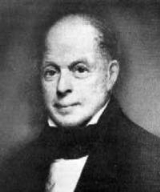
Asher Benjamin
Encyclopedia
Asher Benjamin was an American
architect
and author whose work transitioned between Federal style architecture and the later Greek Revival. His seven handbooks on design deeply influenced the look of cities and towns throughout New England
until the Civil War
. Builders also copied his plans in the Midwest and in the South
.
, shortly after which his father died. The first 30 years of his life would be spent in the Connecticut River Valley. He received his early training from a local builder, and showed an aptitude for architecture by carving Ionic
capitals
for the 1794 modifications to the Oliver Phelps
House at Suffield, Connecticut
. In 1795-1796 he designed and built a stone spiral
staircase in the Old State House
at Hartford
, which had been designed by Charles Bulfinch
. The latter's use of overall symmetry
, blind arch
es, fanlight
s and smooth brick greatly influenced Benjamin, who would help spread the urbane Federal style into the countryside. Gideon Granger
would write of Benjamin that:
He first settled in Greenfield, Massachusetts
, where he built two large houses, including the Leavitt House (today's Leavitt-Hovey House
) for Judge Jonathan Leavitt
, as well as publishing his first handbook, The Country Builder's Assistant (1797). On November 30, 1797, he married Achsah Hitchcock of Brookfield
, who bore him four children. Benjamin later moved to Windsor, Vermont
, where he built three large houses and the Old South Congregational Church (1798).
By 1803, he was in Boston. Listed in the city directory as a housewright, he designed numerous churches and houses. He also appears to have conducted the country's first architecture school, credited with teaching Robert Henry Eddy, Elias Carter, Solomon Willard
, Samuel Shepherd and Ithiel Town
. After his first wife died on January 30, 1805, on July 24 he married Nancy Bryant of Springfield
, who bore him another four children.
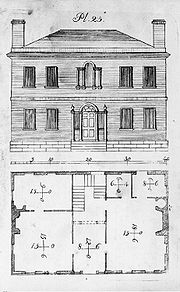 In 1823 and 1824, Benjamin was elected alderman
In 1823 and 1824, Benjamin was elected alderman
of Boston as part of the "Middling Interest," a coalition of middle class entrepreneurs and artisans opposed to the Federalists
, and who supported Josiah Quincy
for mayor. He would help Mayor Quincy and Alexander Parris
plan Quincy Market
. But his political ambitions were curtailed by financial problems, which led to bankruptcy
in 1825. From 1825-1827 he left Boston to supervise construction of locks
, canal
s, roads and mill buildings for the Nashua Manufacturing Company
in Nashua, New Hampshire
. He also designed two churches there before returning to Boston.
Benjamin's greatest influence, however, is due to his pattern books. They were the first written by an American architect, bringing architectural history, style and geometry to ordinary builders in the field. He adapted many designs by James Gibbs
and Colen Campbell
of Great Britain
to fit the scale and finances of New England communities. These handbooks provided superb drawings and practical advice for full house plans, including such details as circular staircases, doorways, fireplace mantel
s, dormer windows, pilaster
s, baluster
s and fence
s. He sketched proposals for dwellings and churches, even a courthouse. The archeological sources of his designs were scrupulously cited, from the Temple of Hephaestus
in Athens
to the Arch of Titus
in Rome
. Other architects, including Ithiel Town and Ammi B. Young
, freely assimilated his plans, as did innumerable carpenters. Indeed, the charm of many early New England towns owes a debt to Asher Benjamin. The Ridge in Orford, New Hampshire
features a series of houses based on designs from his books, many of which remain in print. And although he helped disseminate the Federal style, he was not averse to changing fashion. In fact, his book published in 1830, The Architect, or, Practical House Carpenter, helped redirect American taste towards the Greek Revival.
But as architectural historian Talbot Hamlin writes:
Asher Benjamin died in Springfield at the age of 72.
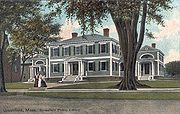
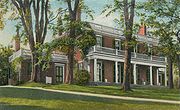
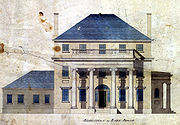
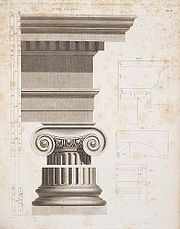
United States
The United States of America is a federal constitutional republic comprising fifty states and a federal district...
architect
Architect
An architect is a person trained in the planning, design and oversight of the construction of buildings. To practice architecture means to offer or render services in connection with the design and construction of a building, or group of buildings and the space within the site surrounding the...
and author whose work transitioned between Federal style architecture and the later Greek Revival. His seven handbooks on design deeply influenced the look of cities and towns throughout New England
New England
New England is a region in the northeastern corner of the United States consisting of the six states of Maine, New Hampshire, Vermont, Massachusetts, Rhode Island, and Connecticut...
until the Civil War
American Civil War
The American Civil War was a civil war fought in the United States of America. In response to the election of Abraham Lincoln as President of the United States, 11 southern slave states declared their secession from the United States and formed the Confederate States of America ; the other 25...
. Builders also copied his plans in the Midwest and in the South
Southern United States
The Southern United States—commonly referred to as the American South, Dixie, or simply the South—constitutes a large distinctive area in the southeastern and south-central United States...
.
Life and work
Asher Benjamin was born in rural Hartland, ConnecticutHartland, Connecticut
Hartland is a town in Hartford County, Connecticut, United States. The population was 2,012 at the 2000 census.-Geography:According to the United States Census Bureau, the town has a total area of , of which is land and is water...
, shortly after which his father died. The first 30 years of his life would be spent in the Connecticut River Valley. He received his early training from a local builder, and showed an aptitude for architecture by carving Ionic
Ionic order
The Ionic order forms one of the three orders or organizational systems of classical architecture, the other two canonic orders being the Doric and the Corinthian...
capitals
Capital (architecture)
In architecture the capital forms the topmost member of a column . It mediates between the column and the load thrusting down upon it, broadening the area of the column's supporting surface...
for the 1794 modifications to the Oliver Phelps
Oliver Phelps
Oliver Phelps was born in Poquonock, Connecticut and moved to Suffield, Connecticut, where he apprenticed to a local merchant. He shortly thereafter became a tavern keeper in Granville, Massachusetts. During the Revolution he was Deputy Commissary of the Continental Army and served until the end...
House at Suffield, Connecticut
Suffield, Connecticut
Suffield is a town in Hartford County, Connecticut, United States. It had once been within the boundaries of Massachusetts. The town is located in the Connecticut River Valley with the town of Enfield neighboring to the east. In 1900, 3,521 people lived in Suffield; and in 1910, 3,841. As of the...
. In 1795-1796 he designed and built a stone spiral
Spiral
In mathematics, a spiral is a curve which emanates from a central point, getting progressively farther away as it revolves around the point.-Spiral or helix:...
staircase in the Old State House
Old State House (Hartford)
The Old State House in Hartford, Connecticut is generally believed to have been designed by noted American architect Charles Bulfinch as his first public building...
at Hartford
Hartford, Connecticut
Hartford is the capital of the U.S. state of Connecticut. The seat of Hartford County until Connecticut disbanded county government in 1960, it is the second most populous city on New England's largest river, the Connecticut River. As of the 2010 Census, Hartford's population was 124,775, making...
, which had been designed by Charles Bulfinch
Charles Bulfinch
Charles Bulfinch was an early American architect, and has been regarded by many as the first native-born American to practice architecture as a profession....
. The latter's use of overall symmetry
Symmetry
Symmetry generally conveys two primary meanings. The first is an imprecise sense of harmonious or aesthetically pleasing proportionality and balance; such that it reflects beauty or perfection...
, blind arch
Blind arch
A blind arch is an arch found in the wall of a building which has been infilled with solid construction so it cannot serve as a passageway, door, or window. The term is most often associated with masonry wall construction, but is also found in other types of construction such as light frame...
es, fanlight
Fanlight
A fanlight is a window, semicircular or semi-elliptical in shape, with glazing bars or tracery sets radiating out like an open fan, It is placed over another window or a doorway. and is sometimes hinged to a transom. The bars in the fixed glazed window spread out in the manner a sunburst...
s and smooth brick greatly influenced Benjamin, who would help spread the urbane Federal style into the countryside. Gideon Granger
Gideon Granger
Gideon Granger was an early American politician and lawyer. He was the father of Francis Granger.Born in Suffield, Connecticut, Granger attended and graduated from Yale University and became a lawyer. He was considered a brilliant political essayist...
would write of Benjamin that:
- "From a poor boy unaided by friends, by his indefatigable industry and talents in a few years he has raised himself to the first rank of his profession."
He first settled in Greenfield, Massachusetts
Greenfield, Massachusetts
Greenfield is a city in Franklin County, Massachusetts, United States. The population was 17,456 at the 2010 census. It is the county seat of Franklin County. Greenfield is home to Greenfield Community College, the Pioneer Valley Symphony Orchestra, and the Franklin County Fair...
, where he built two large houses, including the Leavitt House (today's Leavitt-Hovey House
Leavitt-Hovey House
Leavitt-Hovey House is an historic house located at 402 Main Street in Greenfield, Massachusetts.The house was designed by the noted architect Asher Benjamin in 1797 for Judge Jonathan Leavitt and added to the National Historic Register in 1983.-History:...
) for Judge Jonathan Leavitt
Jonathan Leavitt
Jonathan Leavitt was a prominent Greenfield, Massachusetts attorney, judge, state senator and businessman for whom the architect Asher Benjamin designed the Leavitt House, now the Leavitt-Hovey House on Main Street, in 1797....
, as well as publishing his first handbook, The Country Builder's Assistant (1797). On November 30, 1797, he married Achsah Hitchcock of Brookfield
Brookfield, Massachusetts
Brookfield is a town in Worcester County, Massachusetts, United States. The population was 3,390 at the 2010 census.-History:Brookfield was first settled in 1660 and was officially incorporated in 1718...
, who bore him four children. Benjamin later moved to Windsor, Vermont
Windsor, Vermont
Windsor is a town in Windsor County, Vermont, United States. The population was 3,756 at the 2000 census.-History:One of the New Hampshire grants, Windsor was chartered as a town on July 6, 1761 by Colonial Governor Benning Wentworth. It was first settled in August 1764 by Captain Steele Smith and...
, where he built three large houses and the Old South Congregational Church (1798).
By 1803, he was in Boston. Listed in the city directory as a housewright, he designed numerous churches and houses. He also appears to have conducted the country's first architecture school, credited with teaching Robert Henry Eddy, Elias Carter, Solomon Willard
Solomon Willard
Solomon Willard , was a carver and builder in Massachusetts who is remembered primarily for designing and overseeing the Bunker Hill Monument, the first monumental obelisk erected in the United States.-Background:...
, Samuel Shepherd and Ithiel Town
Ithiel Town
Ithiel Town was a prominent American architect and civil engineer. One of the first generation of professional architects in the United States, Town made significant contributions to American architecture in the first half of the 19th century. He was high-strung, sophisticated, generous,...
. After his first wife died on January 30, 1805, on July 24 he married Nancy Bryant of Springfield
Springfield, Massachusetts
Springfield is the most populous city in Western New England, and the seat of Hampden County, Massachusetts, United States. Springfield sits on the eastern bank of the Connecticut River near its confluence with three rivers; the western Westfield River, the eastern Chicopee River, and the eastern...
, who bore him another four children.

Alderman
An alderman is a member of a municipal assembly or council in many jurisdictions founded upon English law. The term may be titular, denoting a high-ranking member of a borough or county council, a council member chosen by the elected members themselves rather than by popular vote, or a council...
of Boston as part of the "Middling Interest," a coalition of middle class entrepreneurs and artisans opposed to the Federalists
Federalism (United States)
Federalism in the United States is the evolving relationship between U.S. state governments and the federal government of the United States. Since the founding of the country, and particularly with the end of the American Civil War, power shifted away from the states and towards the national...
, and who supported Josiah Quincy
Josiah Quincy
Josiah Quincy is the name of:*Colonel Josiah Quincy I , Revolutionary War soldier, built Josiah Quincy House *Josiah Quincy II , attorney, "the Patriot", newspaper propagandist, son of Josiah Quincy I...
for mayor. He would help Mayor Quincy and Alexander Parris
Alexander Parris
Alexander Parris was a prominent American architect-engineer. Beginning as a housewright, he evolved into an architect whose work transitioned from Federal style architecture to the later Greek Revival. Parris taught Ammi B. Young, and was among the group of architects influential in founding what...
plan Quincy Market
Quincy Market
Quincy Market is a historic building near Faneuil Hall in downtown Boston, Massachusetts. It was constructed 1824–1826 and named in honor of Mayor Josiah Quincy, who organized its construction without any tax or debt.-History:...
. But his political ambitions were curtailed by financial problems, which led to bankruptcy
Bankruptcy
Bankruptcy is a legal status of an insolvent person or an organisation, that is, one that cannot repay the debts owed to creditors. In most jurisdictions bankruptcy is imposed by a court order, often initiated by the debtor....
in 1825. From 1825-1827 he left Boston to supervise construction of locks
Lock (water transport)
A lock is a device for raising and lowering boats between stretches of water of different levels on river and canal waterways. The distinguishing feature of a lock is a fixed chamber in which the water level can be varied; whereas in a caisson lock, a boat lift, or on a canal inclined plane, it is...
, canal
Canal
Canals are man-made channels for water. There are two types of canal:#Waterways: navigable transportation canals used for carrying ships and boats shipping goods and conveying people, further subdivided into two kinds:...
s, roads and mill buildings for the Nashua Manufacturing Company
Nashua Manufacturing Company
The Nashua Manufacturing Company was a cotton textile manufacturer in Nashua, New Hampshire that operated from 1823 to 1945.It was one of several textile companies that helped create Nashua, one of several cities that blossomed along the Merrimack River to take advantage of water power in the early...
in Nashua, New Hampshire
Nashua, New Hampshire
-Climate:-Demographics:As of the census of 2010, there were 86,494 people, 35,044 households, and 21,876 families residing in the city. The population density was 2,719.9 people per square mile . There were 37,168 housing units at an average density of 1,202.8 per square mile...
. He also designed two churches there before returning to Boston.
Benjamin's greatest influence, however, is due to his pattern books. They were the first written by an American architect, bringing architectural history, style and geometry to ordinary builders in the field. He adapted many designs by James Gibbs
James Gibbs
James Gibbs was one of Britain's most influential architects. Born in Scotland, he trained as an architect in Rome, and practised mainly in England...
and Colen Campbell
Colen Campbell
Colen Campbell was a pioneering Scottish architect who spent most of his career in England, and is credited as a founder of the Georgian style...
of Great Britain
Great Britain
Great Britain or Britain is an island situated to the northwest of Continental Europe. It is the ninth largest island in the world, and the largest European island, as well as the largest of the British Isles...
to fit the scale and finances of New England communities. These handbooks provided superb drawings and practical advice for full house plans, including such details as circular staircases, doorways, fireplace mantel
Fireplace mantel
Fireplace mantel or mantelpiece, also known as a chimneypiece, originated in medieval times as a hood that projected over a grate to catch the smoke. The term has evolved to include the decorative framework around the fireplace, and can include elaborate designs extending to the ceiling...
s, dormer windows, pilaster
Pilaster
A pilaster is a slightly-projecting column built into or applied to the face of a wall. Most commonly flattened or rectangular in form, pilasters can also take a half-round form or the shape of any type of column, including tortile....
s, baluster
Baluster
A baluster is a moulded shaft, square or of lathe-turned form, one of various forms of spindle in woodwork, made of stone or wood and sometimes of metal, standing on a unifying footing, and supporting the coping of a parapet or the handrail of a staircase. Multiplied in this way, they form a...
s and fence
Fence
A fence is a freestanding structure designed to restrict or prevent movement across a boundary. It is generally distinguished from a wall by the lightness of its construction: a wall is usually restricted to such barriers made from solid brick or concrete, blocking vision as well as passage .Fences...
s. He sketched proposals for dwellings and churches, even a courthouse. The archeological sources of his designs were scrupulously cited, from the Temple of Hephaestus
Temple of Hephaestus
The Temple of Hephaestus, also known as the Hephaisteion or earlier as the Theseion, is the best-preserved ancient Greek temple; it remains standing largely as built. It is a Doric peripteral temple, and is located at the north-west side of the Agora of Athens, on top of the Agoraios Kolonos hill....
in Athens
Athens
Athens , is the capital and largest city of Greece. Athens dominates the Attica region and is one of the world's oldest cities, as its recorded history spans around 3,400 years. Classical Athens was a powerful city-state...
to the Arch of Titus
Arch of Titus
The Arch of Titus is a 1st-century honorific arch located on the Via Sacra, Rome, just to the south-east of the Roman Forum. It was constructed in c.82 AD by the Roman Emperor Domitian shortly after the death of his older brother Titus to commemorate Titus' victories, including the Siege of...
in Rome
Rome
Rome is the capital of Italy and the country's largest and most populated city and comune, with over 2.7 million residents in . The city is located in the central-western portion of the Italian Peninsula, on the Tiber River within the Lazio region of Italy.Rome's history spans two and a half...
. Other architects, including Ithiel Town and Ammi B. Young
Ammi B. Young
Ammi Burnham Young was an important 19th century American architect whose commissions transitioned from the Greek Revival to the Neo-Renaissance styles. His Second Vermont State House brought him fame and success, which eventually led him to become the first Supervising Architect of the U.S....
, freely assimilated his plans, as did innumerable carpenters. Indeed, the charm of many early New England towns owes a debt to Asher Benjamin. The Ridge in Orford, New Hampshire
Orford, New Hampshire
Orford is a town in Grafton County, New Hampshire, United States. The population was 1,237 at the 2010 census. The Appalachian Trail crosses in the east.-History:...
features a series of houses based on designs from his books, many of which remain in print. And although he helped disseminate the Federal style, he was not averse to changing fashion. In fact, his book published in 1830, The Architect, or, Practical House Carpenter, helped redirect American taste towards the Greek Revival.
But as architectural historian Talbot Hamlin writes:
- "...he, more than any other person is responsible for the character we roughly call 'Late Colonial'; his moldings, his doors and windows and his mantels and cornices decorate or at least inspire the decorations of numberless houses up and down the New England coast and in the New England river valleys."
Asher Benjamin died in Springfield at the age of 72.
Books

- The Country Builder's Assistant, 1797
- The American Builder's Companion, with Daniel Raynerd, 1806. 3rd ed., 1816.
- The Rudiments of Architecture, 1814
- The Architect, or, Practical House Carpenter, 1830
- The Practice of Architecture, 1833
- The Builder's Guide, 1838
- The Elements of Architecture, 1843
Designs



- 1796—Luke Baldwin House, Brookfield, Massachusetts (demolished)
- 1796—Samuel Hinckley House, Northampton, MassachusettsNorthampton, MassachusettsThe city of Northampton is the county seat of Hampshire County, Massachusetts, United States. As of the 2010 census, the population of Northampton's central neighborhoods, was 28,549...
(demolished) - 1796-1797—Coleman-Hollister House, Greenfield, Massachusetts
- 1797 -- Leavitt-Hovey HouseLeavitt-Hovey HouseLeavitt-Hovey House is an historic house located at 402 Main Street in Greenfield, Massachusetts.The house was designed by the noted architect Asher Benjamin in 1797 for Judge Jonathan Leavitt and added to the National Historic Register in 1983.-History:...
(now Greenfield Public Library), Greenfield, Massachusetts - 1797-1798—First Deerfield Academy Building (now Memorial Hall), Deerfield, Massachusetts
- 1798-1799—Stebbins House, Deerfield, Massachusetts
- 1798—Old South Congregational Church, Windsor, Vermont
- 1800—Fullerton House, Windsor, Vermont (demolished)
- 1802—Harriet Lane House, Windsor, Vermont (demolished)
- 1803—Hubbard House, Windsor, Vermont (demolished)
- 1804 -- Charles Street Meeting HouseCharles Street Meeting HouseThe Charles Street Meeting House, is an early-nineteenth-century historic church in Beacon Hill at 70 Charles Street, Boston, Massachusetts. The church has been used over its history by several Christian denominations and is a good example of reuse and adaptive reuse, having recently been renovated...
, 70 Charles Street, Boston, Massachusetts - 1806 -- Old West Church, 131 Cambridge Street, Boston, Massachusetts
- 1806 -- African Meeting HouseAfrican Meeting HouseThe African Meeting House, also known variously as First African Baptist Church, First Independent Baptist Church and the Belknap Street Church, was built in 1806 and is now the oldest black church edifice still standing in the United States. It is located in the Beacon Hill neighborhood of Boston,...
, 8 Smith Court, Boston, Massachusetts - 1808 -- Headquarters House, 54-55 Beacon Street, Boston, Massachusetts
- 1808—60 or 61 Beacon Street, Boston, Massachusetts
- 1808—Fourth Meeting House of the First Church, Chauncy Street, Boston, Massachusetts
- 1809—First Parish Church, Ashby, MassachusettsAshby, MassachusettsAshby is a town in Middlesex County, Massachusetts, United States. The population was 3,120 as of the 2010 census.-Geography:According to the United States Census Bureau, the town has a total area of , of which is land and is water....
- 1809 -- Exchange Coffee House, BostonExchange Coffee House, BostonThe Exchange Coffee House was a hotel, coffeehouse, and place of business in Boston, Massachusetts in the early 19th-century. Designed by architect Asher Benjamin, it was located at Congress Square, on Congress Street, and in its day it was the largest building in Boston, and one of the tallest...
- 1811—Alexander House, Springfield, Massachusetts
- 1811-1812—Fourth Meeting House, Northampton, Massachusetts (demolished)
- 1812-1814—Center Church, New Haven, ConnecticutNew Haven, ConnecticutNew Haven is the second-largest city in Connecticut and the sixth-largest in New England. According to the 2010 Census, New Haven's population increased by 5.0% between 2000 and 2010, a rate higher than that of the State of Connecticut, and higher than that of the state's five largest cities, and...
(with Ithiel TownIthiel TownIthiel Town was a prominent American architect and civil engineer. One of the first generation of professional architects in the United States, Town made significant contributions to American architecture in the first half of the 19th century. He was high-strung, sophisticated, generous,...
) - 1817—Rhode Island Union Bank, Newport, Rhode IslandNewport, Rhode IslandNewport is a city on Aquidneck Island in Newport County, Rhode Island, United States, about south of Providence. Known as a New England summer resort and for the famous Newport Mansions, it is the home of Salve Regina University and Naval Station Newport which houses the United States Naval War...
(demolished) - 1819—Boylston Villa, Princeton, MassachusettsPrinceton, MassachusettsPrinceton is a town in Worcester County, Massachusetts, United States.It is bordered on the east by Sterling and Leominster, on the north by Westminster, on the northwest by Hubbardston, on the southwest by Rutland, and on the southeast by Holden....
(For Ward Nicholas BoylstonWard Nicholas BoylstonWard Nicholas Boylston , a descendent of the physician Zabdiel Boylston , was a man of wealth and refinement, a merchant, a philanthropist and a great benefactor of Harvard University...
) - 1820—Ransom Stiles House, Argyle, New YorkArgyle, New YorkArgyle, New York, refers to one of the following two locations in New York State:*Argyle , New York, which includes*Argyle , New York...
- 1824-1827—The Black House, Ellsworth, MaineEllsworth, MaineEllsworth is a city in and the county seat of Hancock County, Maine, United States. The 2010 Census determined it had a population of 7,741. Ellsworth was Maine's fastest growing city from 2000-2010 with a growth rate of nearly 20 percent...
- 1825—Unitarian Church, Peterborough, New HampshirePeterborough, New HampshirePeterborough is a town in Hillsborough County, New Hampshire, United States. The population was 6,284 at the 2010 census. Home to the MacDowell Art Colony, the town is a popular tourist destination....
- 1826-1832 -- Asa Waters MansionAsa Waters MansionAsa Waters Mansion is an historic mansion at 123 Elm Street in Millbury, Massachusetts.Designed by architect Asher Benjamin, for Asa Waters and Susan Holman Waters, the mansion was built between 1826-32, and added to the National Register of Historic Places in 1978.The Millbury Historical Society...
, Millbury, MassachusettsMillbury, MassachusettsMillbury is a town in Worcester County, Massachusetts, United States. The population was 13,261 at the 2010 census. The town is part of the Blackstone River Valley National Heritage Corridor.-History:... - 1827—Unitarian Church, Canal Street, Nashua, New Hampshire
- 1827—Olive Street Church, Nashua, New Hampshire (demolished)
- 1828—70-75 Beacon Street, Boston, Massachusetts
- 1830—Isaac Munson House, South Wallingford, Vermont
- 1832—Cambridgeport Town Hall, Cambridgeport, Massachusetts (demolished)
- 1833—Asher Benjamin House, 9 West Cedar Street, Boston, Massachusetts
- 1833—7 West Cedar Street, Boston, Massachusetts
- 1834 -- Thatcher Magoun Mansion, Medford, MassachusettsMedford, MassachusettsMedford is a city in Middlesex County, Massachusetts, in the United States, on the Mystic River, five miles northwest of downtown Boston. In the 2010 U.S. Census, Medford's population was 56,173...
(demolished) - 1835—Lexington-Concord Battle Monument, Peabody, MassachusettsPeabody, MassachusettsPeabody is a city in Essex County, Massachusetts, United States. The population is about 53,000. Peabody is located in Boston's North Shore suburban area.- History :...
- 1836—Dr. George Shattuck Monument, Mount Auburn CemeteryMount Auburn CemeteryMount Auburn Cemetery was founded in 1831 as "America's first garden cemetery", or the first "rural cemetery", with classical monuments set in a rolling landscaped terrain...
, Massachusetts - 1836—William Ellery Channing House, 83 Mount Vernon Street, Boston, Massachusetts
- 1836 -- Forest Home, the F. O. J. Smith House, Westbrook, MaineWestbrook, MaineWestbrook is a city in Cumberland County, Maine, United States and a suburb of Portland. The population was 17,494 at the 2010 census. It is part of the Portland–South Portland–Biddeford, Maine metropolitan statistical area.-History:...
(demolished) - 1837—Proposal for the Custom House, Boston, Massachusetts (competition lost to Ammi B. YoungAmmi B. YoungAmmi Burnham Young was an important 19th century American architect whose commissions transitioned from the Greek Revival to the Neo-Renaissance styles. His Second Vermont State House brought him fame and success, which eventually led him to become the first Supervising Architect of the U.S....
) - 1838-1839—Fifth Universalist Church (now the Charles PlayhouseCharles PlayhouseThe Charles Playhouse is an Off-Broadway theater located at 74 Warrenton St. in Boston, Massachusetts near Beacon Hill.Blue Man Group and Shear Madness currently play there....
), 74 Warrenton Street, Boston, Massachusetts - 1840—Richmond Street Church, Dorchester, MassachusettsDorchester, MassachusettsDorchester is a dissolved municipality and current neighborhood of Boston, Massachusetts, United States. It is named after the town of Dorchester in the English county of Dorset, from which Puritans emigrated and is today endearingly nicknamed "Dot" by its residents. Dorchester, including a large...
(demolished) - 1841—Edmund Hastings House, Medford, Massachusetts (demolished)
Further reading
- http://books.google.com/books?id=g6YaAAAAYAAJ&printsec=frontcover&dq=%22asher+benjamin%22&source=bl&ots=Iqy3koJStk&sig=2jaZbtCqIhA9Q-gacZ1cmNNRqFs&hl=en&ei=fpDwS5HOM5SKsgPytaHADw&sa=X&oi=book_result&ct=result&resnum=2&ved=0CBoQ6AEwATgK#v=onepage&q&f=falseThe American Builder's Companion; Or, A System of Architecture, Particularly Adapted to the Present Style of Building, Third Edition, Asher Benjamin, R. P. & C. Williams, Boston, Mass., 1816]

